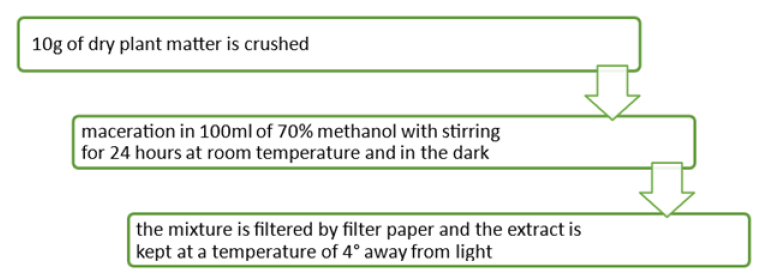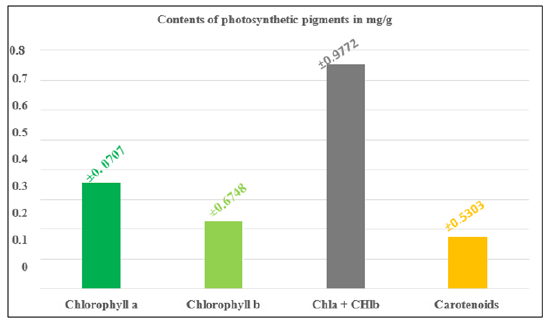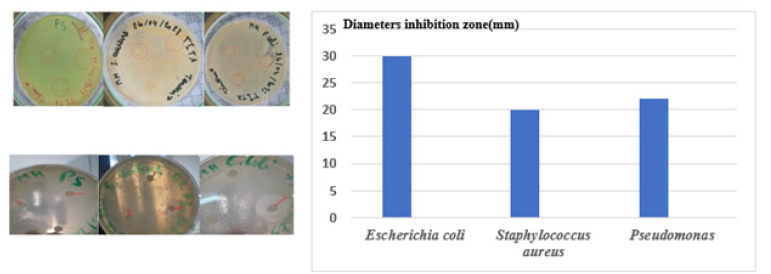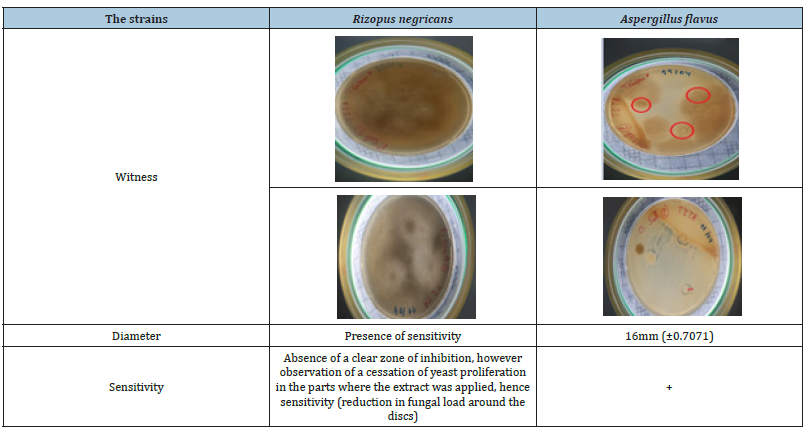- Submissions

Full Text
Examines in Marine Biology & Oceanography
Phytochemical, Biological and Physicochemical Characterization of a Marine Green Alga from the Algerian Coast Ulva rigida C. Agardh, 1823
Hanene Zouaidia1,2*, Mouna Bougueroua1,2 and Zahreddine Djazouli1
1Higher School in Food Sciences and Agro-Food Industries, Algeria
2Food Research Laboratory, ESSAIA, Algeria
*Corresponding author: Hanene Zouaidia, Higher School in Food Sciences and Agro-Food Industries, Algeria
Submission: April 11, 2024;Published: June 10, 2024

ISSN 2578-031X Volume7 Issue1
Abstract
Natural molecules of different origins and mainly those from marine algae create a range of natural bioactive principles with strong therapeutic potential. bioactive compounds present in many species of algae have particularly interesting nutritional properties. This study focuses on determining the phytochemical and nutritional compounds as well as the antioxidant, antibacterial and antifungal activity of marine green algae. Ulva rigida harvested on the Algerian coast. The different extracts of the ulva were analyzed and subjected to several physicochemical and biological tests. The results of the various dosages of primary and secondary metabolites revealed that Ulva rigida is rich in water-soluble proteins, total sugars and polyphenols while they are low in amino acids and total lipids. This algae studied is an excellent natural source of antioxidants and has great antibacterial activity, which is not the case for the antifungal activity which was found to be very weak against the yeast strains studied. All these in vitro results are only a first step towards the search for naturally active biological substances from this green algae with the aim of using it in the bioformulation of various food and agro-food products. Further tests are planned to confirm the bio-activity of the algae.
Keywords:Green algae; Bioactive compounds; Ulva rigida; Antioxidant; Antibacterial; Antifungal activity
Introduction
Marine organisms and their environments are a significant source of active molecules with a unique chemical structure. Algae which are generally attached to a substrate are part of these organisms [1]. Coastal populations have long used marine plants as a source of food due to their high nutritional values. This value is justified by several factors including the presence of a variety of minerals which provide essential macroelements and trace elements, proteins in significant quantities, vitamins and a reduced quantity of fat. Algae of the genus Ulva have been used in various fields and are considered today excellent feeds and dietary supplements for livestock, [2] showed that they can be considered as an average quality substrate for goats. From another perspective, it would be interesting to replace synthetic preservatives with natural substances of plant origin, micro-algae and macro-algae [3]. Green algae Ulva rigida is a marine organism that is attracting increasing interest due to its remarkable nutritional value. This algae, also known as sea lettuce, has a composition rich in essential nutrients, making it a potentially beneficial food for our health.
This work aims to evaluate the nutritional and phytochemical quality by highlighting its key components, its potential benefits for humans and how it can be used in food as well as other areas. by closely examining its composition of nutrients and bioactive substances. In order to better understand its potential benefits for human health, this study also aims to study the antioxidant, antibacterial and antifungal activity of green algae. Ulva rigida with a view to using it in the bioformulation of various agro-food products in the future.
Material and Methods
Ulva rigida was collected in February 2023 at the width of “the broken boat beach” located east of Algiers between 36°76’754”06N and 32°22’15”05E. the sample is preserved in sea water and transported inside a box in a black plastic bag. The plant was washed well and then taken to traditional air drying. A methanolic extract previously prepared from the algae powder according to the protocol described in Figure 1 was produced and stored at a temperature of 4 °C to be used for the various analyses; we started with a phytochemical screening based on colorimetric reactions to verify the presence of bioactive compounds by precipitation, then a quantitative evaluation of the primary metabolites (content of total sugars and ethanol solubles, amino acids, crude proteins and water soluble as well as the rate in fat) and secondary (level of total polyphenols, tannins and falvonoids) according to Spectrophotometric methods as well as the evaluation of the different biological activities (antioxidant and antimicrobial). The physicochemical parameters carried out are: humidity, ash content, refractive index and pH. A sample of sea water from the harvest site was also analyzed to determine the physicochemical characteristics of the plant’s living environment. These include pH, conductivity, hardness, dissolved oxygen, salinity and turbidity.
Figure 1:Steps for preparing the methanolic extract of algae.

Result and Discussion
Seawater analyzes
Analysis of the seawater from the collection site was carried out within 24 hours of collection. The measurements are made at a temperature of 25 °C (Table 1). The results of [4] show that algae absorb nutrients initially present in seawater until they are exhausted. The medium is not concentrated, the longer the culture lasts, the more the algae have a lack of nitrogen, the more their growth will slow down. Analyzes of sea water are important to estimate the phytochemical and nutritional quality of the algae. Salinity acts on the algae either by dissolving the salt in the water or by concentrating the salt in the water. These temporary or permanent changes can harm the life of the algae. Areas with variable salinity limit the adaptation of algae. This instability affects the metabolism, sometimes disrupting it to such an extent that it leads to the elimination of species. Only green algae succeed in adapting [5].
Table 1:Results of physico-chemical parameters of seawater.

Extract yield
The active compounds are present in algae in small quantities, the extraction of secondary molecules from the algae is a method which makes it possible to obtain a concentrated extract with the slightest change in the characteristics of these molecules. It is obtained after 24 hours of maceration in methanol, this will help us determine the yield of extract from 10g of crushed and dried algae. The yield of the extract is estimated at (22.62%±0.037). The extraction yield depends on the nature of the solvent, its composition and its concentration, the extraction method as well as the physicochemical properties of the compounds to be extracted [6]
Physicochemical characterization of U. rigida
pH: The pH of the green alga U. rigida is (5.98±0.0152), we see that our sample is relatively acidic [4]. Observed in his study on two species of the same genus: Ulva armoricana and Ulva obscura which tolerate great variability in pH. However, pH levels that are too high (around 10) are harmful to the cultivation of these plants. The pH in a range of suitable values for good cultivation of these algae can be between 7.5 and 9.5 [7].
Water content: According to the literature, the ratio of water content of Ulva rigida contains between 76% and 83.56% water [8]. The raw water content of our sample for 1g of fresh algae is evaluated at 79.4% (±0.8962) which is in correspondence with the result of [8]. According to [5], the mass of water present in the algae is responsible for the penetration of light depending on the quantity and quality of this algae. This value depends on the nutrients contained in the medium.
Ash content: The calculation of the ash content was done
according to the following equation:
TC %=(weight of crucible and sample after ashing – weight of
empty crucible (g)) / mass of sample (g) *100.
The crude ash content obtained for 2g of crushed dry algae is estimated at 16.625% (±0.01). Algae have a higher ash content than land plants. Therefore, the biochemical composition of sea lettuce varies depending on geographic distribution and seasons as well as important environmental factors (water temperature, salinity, light, available nutrients and minerals) [9]. The mineral content in algae generally varies between 8% and 40% [10,11], however in Ulva rigida varies from one study to another at an interval of [11%, 35%] such is the result obtained for this work.
Primary metabolites
Total protein content: Several studies have shown that the amino acid composition varies depending on the species, geographic region and life stage [10]. The crude protein content of our algae is 21.89%. The protein content of marine algae mainly depends on the species and environmental conditions [12], other studies have shown that the protein content is high in some locations compared to others. This is due to the level of pollution and low temperature of these regions [11].
Water-soluble proteins: According to the calculations carried out according to the equation provided by the calibration curve, the value of water-soluble proteins is estimated at 100.69 mg/g of DM (±0.46). The extraction and dosage of proteins must be adapted to the matrix to be studied and lead to a total [12] extraction without modification of the latter, the content varies according to several parameters. Noted in his research an increase in protein levels due to pollution. According to a study by [13], a change of season influences the protein content, and reaches its maximum in December.
Amino acids: The level of free amino acids in algae of the Ulva genus is estimated at: 0.834 mg/g of DM (±0.0033). The essential amino acid profiles of Ulva rigida and Ulva lactuca appear to be relatively close to those of legumes and oilseed plants. Aspartic acid is the most abundant amino acid in the species Ulva rigida, it is rich in glycine, alanine and poor in histidine, methionine and cysteine [14].
Dosage of total ethanol-soluble sugars
We recorded an average content estimated at 178.2mg/g of DM (±0.0466) which is considered relatively low which can be explained on the one hand. By the state of the plant material that we used in the dry state while [15], who considers that the carbohydrates of Ulva rigida contain 426mg/g of FW of soluble polysaccharides used the lethal alga costs. On the other hand, by the influence of luminosity on the sugar composition of algae. This was affirmed by the observation of [4]. In his study on algae of the family Ulvaceae in particular the species Ulva armoricana and he mentioned that there had been a strong decrease in the total sugar content with the decrease in the glucose content when they are placed in the dark, which was exactly our case.
Starch dosage: Green algae accumulate only a small amount of starch and that amounts to around 20 to 40% of total sugars [16]. The starch content of this sample is estimated at 11.5 mg/g of DM and which presents only 6.45% of all polysaccharides. Our result expressed as a percentage is perceptibly low when comparing it with the percentage of [16] and this shows that starch degradation was accelerated in the dark confirmed by many authors [16-19].
Total lipids, fat: The lipid content of our sample of Ulva rigida extract was found to be relatively low with a content of 1%. However, our result still remains within the range of standards when comparing with previous work on the same species which indicates that the total lipid content in Ulva rigida is variable from 0.79 to 12% [8] depending on environmental factors, cultivation technique, composition of the environment and species.
Secondary metabolites
Dosage of polyphenols: Phenolic compounds exhibit various biological activities including antioxidant and antimicrobial properties. There are at least 8000 different bioactive polyphenols. The average content of polyphenols that we recorded in Ulva rigida is estimated at 38.77mg Eq AG/g of DM (±0.03329).According to [20], different results are difficult to compare with bibliographic results, because the use of different extraction methods reduces the possibility of comparison between studies. The studies of [21], on Ulva rigida show that the total phenolic content is of the order of 9mg/g (mg of phloroglucinol acid equivalent per g of dry algae extract). The average content of polyphenols that we recorded in Ulva rigida is estimated at 38.77mg Eq AG/g DM (±0.03329). Studies by [21], show that the total phenolic content of Ulva rigida is of the order of 9mg/g (mg of phloroglucinol acid equivalent per g of dry algae extract) and also confirms that the rate varies considerably depending on the type and polarity of the extraction solvents, while the values mentioned by on Ulva lactuca and Euglypha compressa by [22] show that the contents of polyphenols extracted by methanol are of the order of 52.67 and 14.47±0.60 respectively.
Flavonoids: The flavonoid content of algae of the genus Ulvae contains varying levels between 4-8mg/g of dry matter. Information on the flavonoid content of algae is rare. A recent study on the distribution of flavonoids in 27 species of marine algae showed that they had a completely different flavonoid composition from fruits and vegetables [23]. Other studies have reported that algae macros are rich in catechins, flavonols [24]. The level of flavonoids present in the methanolic extract of Ulva rigida at the dosage carried out is : 87.97mg/g of DM (±0.0032). There are few studies on the flavonoid content of marine algae [25]. The results of the analysis of report that the algae of the genus Ulva contains variant contents between (40.46 as a maximum value for the chloroform extract and a minimum value of 4.39μg/mg for methanolic extract). How algae is stored and exposure to light can affect flavonoid levels [26].
Photosynthetic pigments: The contents of chlorophylls a and chlorophylls b and carotenoids in the Ulva rigida extract are represented in mg/g of FW in Table 2 and Figure 2. According to [8], the rate of chlorophyll a of Ulva rigida which was harvested in the Chilika region in India is 13%, that of chlorophyll b of 7.5% and that of carotenoids is 4.5%. The chlorophyll content was estimated at 21%. The contents of photosynthetic pigments in our sample and those of Satpati are relatively close, the content of chlorophyll a and chlorophyll b of our sample is greater in relation to the carotenoid content, these results are in agreement with the study of [8].
Figure 2:Contents of photosynthetic pigments in mg/g of FW.

Table 2:Contents of photosynthetic pigments.

Antioxidant activity: The results of the percentages of DPPH inhibition are mentioned in (Table 3). According to the results obtained (IC50 value is 32μg/ml), we notice a proportional relationship between the concentration and the percentage of inhibition. At a low concentration of 20μg/ml, the methanolic extract shows a low DPPH reduction percentage of approximately 1.26%, at a medium high concentration 28μg/ml. The DPPH reduction percentage is estimated at a value of 30.84%. The IC50 value expressed in μg/ml was determined from the regression line of the percentage of inhibition as a function of the concentration for each sample.
Table 3:The concentrations carried out for the percentage inhibition assay.

Antibacterial activity: The study of the antibacterial and antifungal power is carried out by diffusion on solid medium using the disk method, it makes it possible to estimate the antibacterial effect of our extract by measuring the diameter of the inhibition zones around the discs impregnated in the methanolic extract (Figure 3). The results of this analysis are presented in the following (Table 4). The algae extract has a strong effect on E. coli, their inhibition zone is 30mm±0.7, Pseudomonas has less sensitivity than E. coli, their inhibition diameter is approximately 22mm±0.4. As for Staphylococcus aureus, they proved to be more resistant to the extract compared to other species of bacteria with a diameter of 20mm±0.2. Comparing with the control, the results show that Gramnegative bacteria (Escherichia coli and Pseudomonas aeruginosa) are more sensitive than Gram-positive bacteria (Staphylococcus aureus).
Table 4:Inhibition diameter for each bacteria.

Figure 4:Evaluation of the antibacterial activity of the methanolic extract of Ulva rigida.

Antifungal activity: Considering the problem of spoilage and mold damage to fruits and vegetables, many studies have been conducted on the antifungal effects of natural plant-derived products. The results are expressed in Table 4. The methanolic extract of Ulva rigida has no significant or even non-existent antifungal activity, this will allow it to be used in the preparation and formulation of cheeses based on mushrooms (Table 5).
Table 5:Result of the antifungal activity of the two strains studied.

Conclusion
Marine algae are a potentially rich source of primary and secondary metabolites and also possess bioactive compounds that inhibit the growth of certain pathogenic Gram-positive and Gramnegative bacteria as well as certain fungi. Among these metabolites, we find vitamins, fatty acids, antioxidants such as polyphenols.
It is in this context that we undertook this study which is part of the valorization of marine green algal biomass from the Algerian coasts. This study focused on the phytochemical analysis and determination of nutritional quality as well as the evaluation of biological activities, namely the antioxidant, antimicrobial and antifungal activities of a green marine alga Ulva rigida, a species common in the coast. Algerian, with a view to defining its still poorly known potential with the aim of using it for bioformulation of various agro-food products. The plant material was used in both its fresh and dry states, and also with a methanolic extract. The results indicate an extract yield estimated at 22.62% (±0.037) for methanol. The dosage of the different nutrients made it possible to record a high total phenol content of 0.383mg EAG/mg extracted. The quantitative dosage of the main classes of primary and secondary metabolites made it possible to record a high content of total proteins with a percentage of 21% of which the watersoluble proteins present a value of (100.69mg/g of DM ±0.46), a content of polyphenols (38.77mg Eq AG/g DM +/-0.03329) and a low total lipid content which presents only 1% DM. Concerning the antioxidant activity, we highlight the capacity of the extract of the algae studied to reduce DDPH. This extract has significant antioxidant activity which presents strong anti-radical activity, with an IC50 of 32μg/ml which indicates that the algae studied is a good natural source of antioxidants. The antibacterial activity determined by methanolic extract of our alga against bacterial strains shows that Gram-negative bacteria are more sensitive than Gram-positive with an inhibition diameter of 30mm±0.7mm. For Escherichia coli and 20mm±0.2 for Staphylococcus aureus. While for the effect the two mushrooms studied are resistant to the methanolic extract. Rhizopus nigricans presented a slight sensitivity presented by a reduction in the fungal load around the discs and on the other hand a low diameter of 16mm (±0.7071) was recorded for Aspergillus flavus. In perspective, I am interested in the incorporation of this algae in the organic formulation of foods to prevent several diseases thanks to their high nutritional potential, this would require a more in-depth and more detailed study of this plant
References
- Valerie PJ, Littler MM, Littler DS, Fenical W (1987) Evidence for chemical defense in the tropical green alga Caulerpa ashmeadii (Caulerpaceae: Chlorophyta): Isolation of new bioactive sesquiterpenoids. Journal of Chemical Ecology 13(5): 1171-1185.
- Ventura MR, Castanon JIR (1998) The nutritive value of seaweed (Ulva lactuca) for goats. Small Rumin Res 29(3): 325-327.
- Santoyo G, Orozco-Mosqueda MC, Govindappa M (2012) Mechanisms of biocontrol and plant growth-promoting activity in soil bacterial species of Bacillus and Pseudomonas: A review. Biocontrol Science and Technology 22(8): 855-872.
- Champenois J (2009) Influence of the cultivation conditions of marine algae of the order Ulvales on their growth and composition. Doctoral Thesis, Center for the study and development of algae.
- Moreau RA, Whitaker BD, Hicks KB (2002) Phytosterols, phytostanols, and their conjugates in foods: Structural diversity, quantitative analysis, and health- promoting uses. Progress in Lipid Research 41(6): 457-500.
- Tefiani C (2015) The biological properties of the essential oils of Curcuma longa, Ammoides verticillata and Thymus ciliatus sp. eu-ciliatus. Doctoral Thesis in Sciences from the University of Mostaganem, pp. 145.
- Moll UM, LaQuaglia M, Bénard J, Riou G (1995) Wild-type p53 protein undergoes cytoplasmic sequestration in undifferentiated neuroblastomas but not in differentiated tumors. Proceedings of the National Academy of Sciences 92(10): 4407-4411.
- Satpati GPR (2011) Biochemical composition and lipid characterization of marine green alga Ulva rigida- A nutritional approach. Journal of Algal Biomass 2(4): 10-13.
- Messyasz B, Szczuka E, Kaznowski A, Burchardt L (2010) The spatial changes of phytoseston and microbiological parameters in lowland rivers during the summer period. Pol J Environ Stud 19(6): 1269-1277.
- Fleurence J, Le Coeur C, Mabeau S, Maurice M, Landrein A (1995) Comparison of different extractive procedures for proteins from the edible seaweeds Ulva rigida and Ulva rotundata. Journal of Applied Phycology 7(6): 577-582.
- MacArtain P, Gill CI, Brooks M, Campbell R, Rowland IR (2007) Nutritional value of edible seaweeds. Nutrition Reviews 65(12): 535-543.
- Dawczynski C, Schubert R, Jahreis G (2007) Amino acids, fatty acids, and dietary fibre in edible seaweed products. Food chemistry 103(3): 891-899.
- Rouxel C, Daniel A, Jérôme M, Etienne M, Fleurence J (2001) Species identification by SDS-PAGE of red algae used as seafood or a food ingredient. Food Chemistry 74(3): 349-353.
- Shuuluka D, Bolton JJ, Anderson RJ (2012) Protein content, amino acid composition and nitrogen-to-protein conversion factors of Ulva rigida and Ulva capensis from natural populations and Ulva lactuca from an aquaculture system, in South Africa. Journal of Applied Phycology 25(2): 677-685.
- Taboada C, Millan R, Miguez I (2009) Composition, nutritional aspects and effect on serum parameters of marine algae Ulva rigida. Journal of the Science of Food and Agriculture 90(3): 445-449.
- Hulst CD (1997) Soluble starch synthetase II: The enzyme responsible for building amylopectin crystals in Chlamydomonas reinhardtii. Doctoral dissertation, Lille 1.
- Williams RS, Trumbly RJ, MacColl R, Trimble RB, Maley F (1985) Comparative properties of amplified external and internal invertase from the yeast SUC2 gene. J Biol Chem 260(24): 13334-13341.
- Rincones RE, Yu S, Pedersen M (1993) Effect of dark treatment on the starch degradation and the agar quality of cultivated Gracilariopsis lemaneiformis (Rhodophyta, Gracilariales) from Venezuela. Hydrobiologia 260: 633-640.
- Wiencke C, Clayton MN, Gómez I, Iken K, Lüde UH, et al. (2007) Life strategy, ecophysiology and ecology of seaweeds in polar waters. Reviews in Environmental Science and Bio/Technology 6: 95-126.
- Trabelsi N, Falleh H, Jallali I, Ben Daly A, Hajlaoui H, et al. (2012) Variation of phenolic composition and biological activities in Limoniastrum monopetalum organs. Acta Physiol Plant 34: 87-96.
- Trigui M, Gasmi L, Zouari I, Tounsi S (2012) Seasonal variation in phenolic composition, antibacterial and antioxidant activities of Ulva rigida (Chlorophyta) and assessment of antiacetylcholinesterase potential. Journal of Applied Phycology 25(1): 319-328.
- Oucif H (2018) Valorization of vegetables from the Algerian west coast with antioxidant and hormonal potential (PhD). Oran 1 University, Algeria.
- Yoshikawa T, Yamamoto Y, Naito Y (2000) Free radicals in chemistry biology and medicine. OICA International (UK) Ltd, pp. 1-500.
- Ho YS, Xiong Y, Ma W, Spector A, Ho DS (2004) Mice lacking catalase develop normally but show differential sensitivity to oxidant tissue injury. Journal of Biological Chemistry 279(31): 32804-32812.
- Zeng RS, Luo SM, Shi YH, Shi MB, Tu CY (2001) Physiological and biochemical mechanism of allelopathy of secalonic acid F on higher plants. Agronomy Journal 93(1): 72-79.
- Sarojini S, Tamir A, Lim H, Li S, Zhang S, et al. (2012) Early detection biomarkers for ovarian cancer. Journal of Oncology 2012: 709049.
© 2024 Hanene Zouaidia. This is an open access article distributed under the terms of the Creative Commons Attribution License , which permits unrestricted use, distribution, and build upon your work non-commercially.
 a Creative Commons Attribution 4.0 International License. Based on a work at www.crimsonpublishers.com.
Best viewed in
a Creative Commons Attribution 4.0 International License. Based on a work at www.crimsonpublishers.com.
Best viewed in 







.jpg)






























 Editorial Board Registrations
Editorial Board Registrations Submit your Article
Submit your Article Refer a Friend
Refer a Friend Advertise With Us
Advertise With Us
.jpg)






.jpg)














.bmp)
.jpg)
.png)
.jpg)










.jpg)






.png)

.png)



.png)






